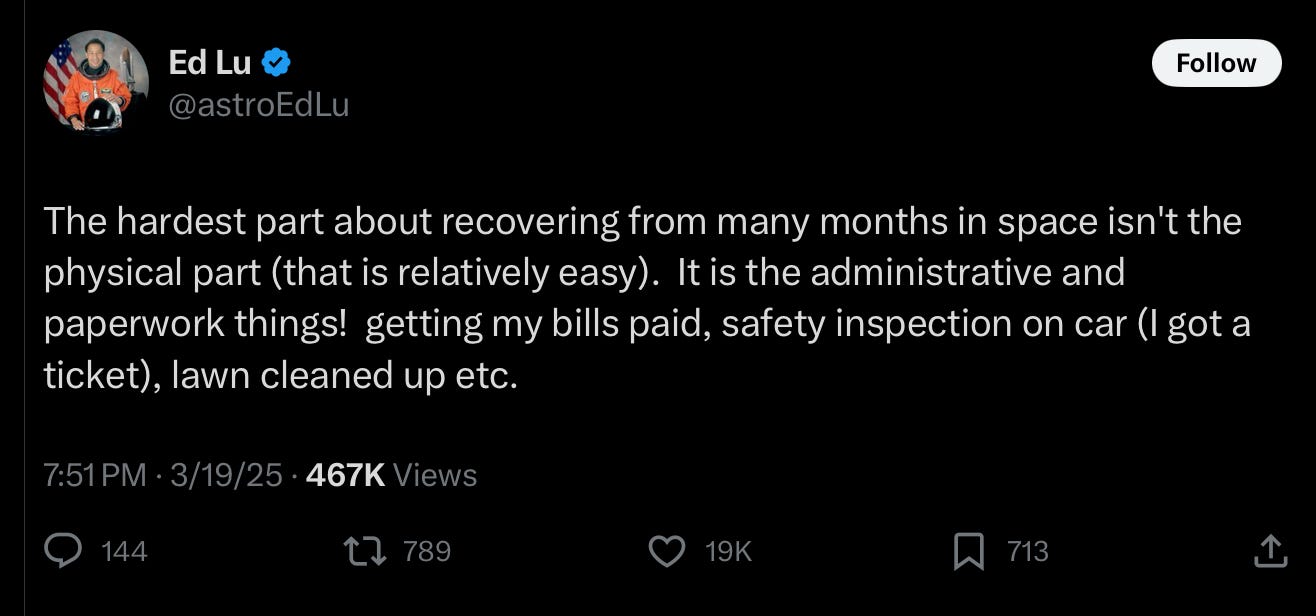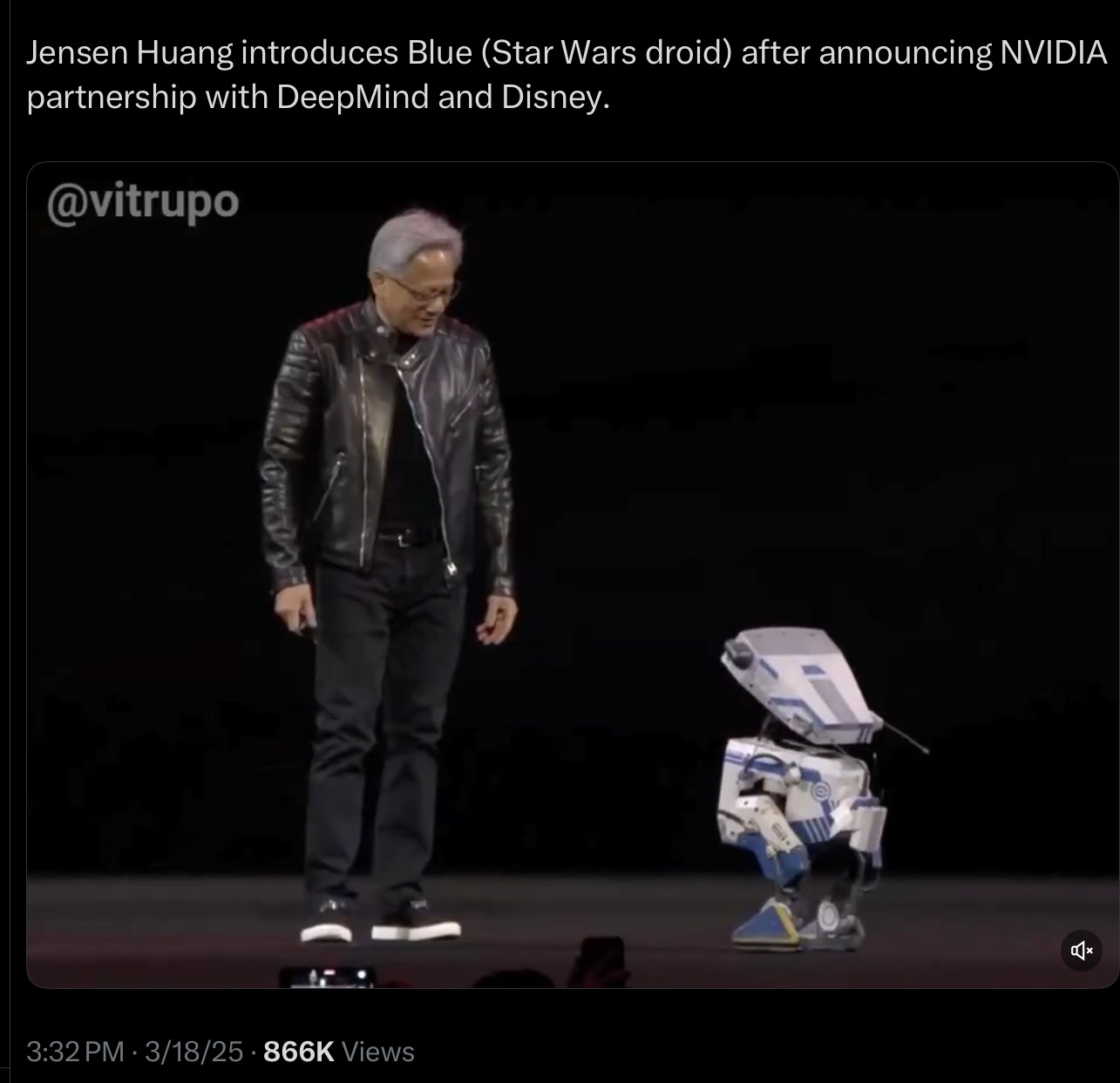The Process of Making Something Heavy
Also: Space Admin, Red-Chip Art, and Deepmind Disney Droids
I enjoyed
’s post on splitting out work and into light and heavy.Light mode is fast and iterative, producing work that’s quick to make but just as quick to fade. It’s the mode of rapid experiments, side quests, and prolific posting. Heavy mode is slower, deliberate, and intentional (often hermit mode). It’s the mode of deep work that builds over time and carries lasting weight.
Broadly, light work is easy work, and today, it also means it might be something that an AI can spit out easily. It’s tweets, a weekly newsletter, and “light reps” of work like she describes. Heavy work isn’t necessarily just heavy in its cultural value: aiming to create a masterpiece, but it’s also “heavy” for the creator. Dense work.
Creation isn’t just about output. It’s a process of becoming. The best work shapes the maker as much as the audience. A founder builds a startup to prove they can. A writer wrestles an idea into clarity. You don’t just create heavy things. You become someone who can.
I’ve been thinking a lot about this, especially when *every* creator is currently questioning their process in the wake of technological change (generative AI being the forerunner). Many creators *also* enjoy the process, but it’s still mostly only you as the creator that see and experience that. Yes, some creators have smartly started showcasing process as a part of their work, but it’s still largely separate. But, the process, in reality, unless you’re Francis Ford Coppola bankrolling his masterpiece through a wine farm, is something creators have to think about above and beyond it as a creative path to take. If creators had unlimited time (and money), they’d choose the process that worked for them and their pursuits. You could write a song on a guitar or a piano, knowing that the instrument is a habitual creative path that leads to different outcomes. In the same way that starting a story from an outline or on the first page changes it. But, our process is also decided for us in terms of what needs to get done. Sometimes we can’t make something heavy because it’s not always for us to decide. But, the question of the process remains interesting and having new technology ask us to re-evaluate it is a creatively destructive force that can also yield new perspectives.
To create a heavy thing, by virtue of Anu’s definition, requires a process that’s almost like a Hero’s Journey: the artist that overcomes their demons to newfound rebirth, becoming a phoenix rising from the ashes, coming home having changed. And then the world is richer for it.
Process matters for me, because the process is a part of the becoming. It’s the venue for the conversation you’re having with yourself and the world.
And so, you’re always pre and post it, always desiring to get back into it.
At any given time, you’re either pre–heavy thing or post–heavy thing. You’ve either made something weighty already, or you haven’t. Pre–heavy thing people are still searching, experimenting, iterating. Post–heavy thing people have crossed the threshold, and it shows. They’ve made something substantial—something that commands respect, inspires others, and becomes a foundation to build on. And it shows. They move with confidence and calm.
This has been my life when I first made a small game as a teenager. It’s so irrevocably anchored by my creative projects that I sometimes feel I can tell time better by framing what heavy thing I was working on at the time.
It sounds romantic. But, the conclusion I want to get to, is to ask *why* the creator feels almost enslaved in birthing the heavy things. In part, it’s an attachment to the process.
Creative people are restless souls, forever chasing the horizon until they’ve made something substantial. We spend our lives crafting weighted blankets for ourselves—something heavy enough to anchor our ambition and quiet our minds.
And ain’t that the truth.
In the wake of creative destruction like generative AI or in the case of my personal life (divorce), it forces us to stop and pay attention again to our process. For example, I realised that maybe one of the reasons I enjoy creating heavy things is that it is where I have control, autonomy, and mastery. Filled with deep grief after my divorce, out of habit, I threw myself back into finishing my novel. It’s a realisation that an attachment to the heavy process of creating is an attachment to the ritual of looking down at my hands and not up at the world.
As Anu, mentions. It’s ultimately a balance. Don’t let everything be so heavy such that you don’t forget to go on those “side quests”. Shortcut the process. Create little light things. Go outside. Look up.
Bonus Content!
📺 Watching - Severance, White Lotus
Take a bow, Severance. While it felt like it dipped a bit here and there, I can usually forgive the hiccups for a stellar ending. And wow that was amazing. I really adore it when media plays with tonal shifts and expectations too. The dips in the show mostly came from the fact that sometimes the world-building wasn’t very clear to me.
✍️ Writing - Novel #2
Still hoping to finish draft 2 in the coming weeks. Getting close. Been putting in a lot of work. 🤞
🏃♂️ Walking/Running
Been a bit quiet on this front. I *have* still been walking and running frequently, but there’s two big events coming up. One is: I entered my first ultra trail event. 35km at the end of November in Cape Town. 😱. And then secondly, I’ve been planning a big walking trip which has taken a good portion of my time. I’ll share more soon. :)
💾 Links
Space Admin
I found this particularly dystopian.
Realistically, no reason for it not to be true, but I can’t imagine the bureaucratic anxiety of having to organise your administrative life from space after you’re *stuck* up there. The real horror isn’t malevolent aliens, but the inability to take care of shit that needs to be taken care of. “Hello, hi, yes, please don’t send me more tickets. I’m literally in space right now.” Maybe it’s just more acute for me, being an immigrant that also had to take care of things back in their home country. 😅. Multiply that by the vastness of space.
Red-Chip Art
A funny article by Annie Armstrong describing “Red-Chip” (as opposed to “Blue Chip” art). It’s a new consensus on high-price tag art that’s not driven by a trad art elite, but a mixture of hypebeast collectible culture merged with the algorithm.
“The physical world matters to them less,” Cappellazzo added. “They care more about experiences, maybe.” Red-chip art usually has that experimental element: you eat the banana, you strap on the boots, you buy it on a digital marketplace, flex it on Instagram, savor for the serotonin boost, and then sell it again. The instinct mirrors the fast-fashion trend that sees thousands of teenagers reselling their Shein garments after wearing them only once. It is algorithmic art, boosted by social media, popular because everyone agrees it is popular, because the feed keeps saying it is popular. When you surrender your taste to an algorithm, you “lose something essential to yourself,” Cappellazzo said.
Regardless of the somewhat condescending tone to the bro-y-ness of red-chip art, I think it’s interesting to be aware of what is culturally desirable downstream of the algorithm even if it’s not your thing.
Deepmind Disney Droids
Pretty cool to see Star Wars droids coming to life in this manner.
I’d love to see more LLM mascot gizmos in general. In November I bumped into those cute delivery bots in Miami and even those rudimentary ones are adorable.
🎶 Music
Casino Versus Japan - Strahllücke
Something I enjoy about into a musician with a large discography is that sometimes you just have to listen to their music a few times before songs you skipped in the past suddenly sound profound. This is a beautiful ambient track from Casino Versus Japan’s latest album!
Have a great week friends. May there be a lovely sunset.
Simon



